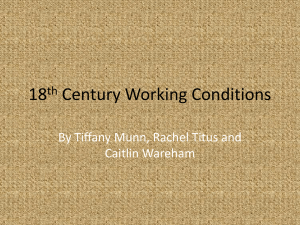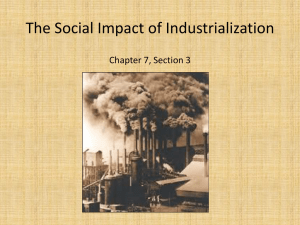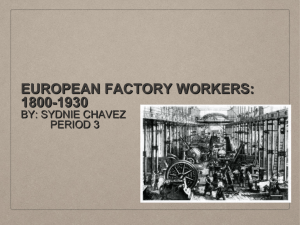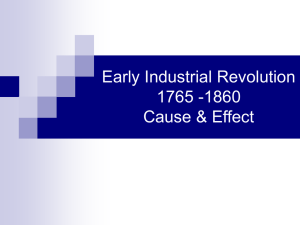An overview of Movement of recovered factories by
advertisement
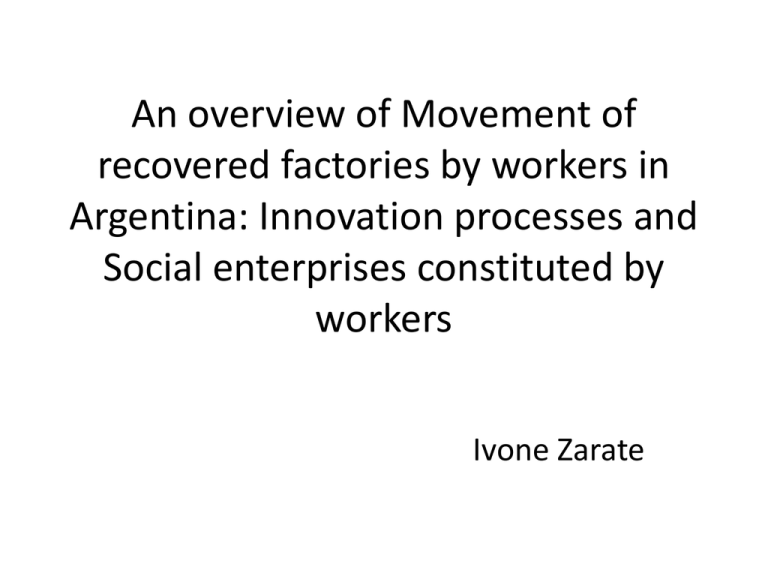
An overview of Movement of recovered factories by workers in Argentina: Innovation processes and Social enterprises constituted by workers Ivone Zarate Context • Political, Financial Crisis 2001 • General Bankrupcies • Massive lay offs of workers After 10 years… • The experience on recovered factories by workers has an accumulated experience of 10 years. • 80 percent of recovered factories are the product of bankruptcy Recovered factory • Is a factory under the collective management of the workers, ocurred after declaration of bankrupcy Self Management (Collective Management) • Implies the collective way of takin decisions in different spheres (Customer service, methods of ptoduction, planification, etc) • The recovered factories are an expression of a mixture of organization arrangements (more or less legal) in order to maintain the employment level after bankruptcy situation or abandonment of control by capital owners. • It includes situation as the occupation of factories and the resistance from workers, and the possibility for the workers to buy the enterprise. The group of workers decided to constitute themselves into cooperative as there is a legal vacuum in the system that did not contemplate situations that resulted from the general bankruptcy and financial crisis. Movement of recovered enterprises (More combative) Movement of recovered factories • These organizations do not base their discourse in the establishement of cooperatives, but favor a more horizontal form of organizing and decision making, with the promotion of same wage for every worker, the constitution of assemblies for participation and decision making and the rejectance to admitt managerial cadres in the oranization. How did it happen? • First, came the occupations of the factories by workers. • Second, workers started to look for legal vaccum in the legal system, • Later, new definition of laws were accepted. • These organizations demanded for the modification of bankrupcy laws and the conformation of an assistance fund aimed at recovered enterprises. Case: Fabrica Sin Patrones (Factory without bosses) • Is a factory of ceramic located in Neuquen, Argentina. • Since early 2002 is under the control of workers, after declaration of bunkrupcy in 2001. (Company was previously known as Zanon). • It assumed the legal form of cooperatives. • Decisions are taken in participatory assembly of workers. Innovation and Social Enterpises • • Where can we locate innovation? Political dimention (assembly) Technical dimention in production processes. • filling in the gaps in Laws and institutions..Building bridges to satisfy human needs. The recoveres factories as places of innovation and cultural creation.Work culture and political culture put toghether. The workers pushed for innovation in the legal arrangements, • Law of expropriation • Law of concourses and bankruptcy. June 2011. It allows for the continuation of production activities even though the work cooperative may be under process f formation. It also gives priority for workers in order to make offers in the concourse after bankruptcy. • Modification in the concept and framing of enterprises, the possibility that worker can continue working after bankruptcy and using art of profits to provide funds to hospitals, schools, community centers, etc. Workers also have the advantage of getting adjudication of infrastructure within the factory through credits and quota payment system. In case the capital owner had a debt in the form of salaries, and wage benefits, the judge can adjudicate the infrastructure within the factory in direct way towards the workers. Moreover, during the bankruptcy process, the interests on wages are not suspended and workers are placed in equal conditions with privileged investors who were supposed to receive payments with priority during the bankruptcy process in the previous legal arrangement. Innovation • The University in the Factory One of the main features of the movement of recoverd factories is its vocation to go beyond the limits of the market and establish social links and networks with social movements and organizations of Civil Society. First, cultural and artistic activities were promoted. Later, some recovered factories pushed and established Popular Bachilleratos, aimed at the formation of adult people withouth the high school credentials and focusing education from the perspective of workers. Later on, University of workers was established in 2010. Metalurgic enterprise, IMPA It was the first recovered factory in May 1998. It also promotes links with society and created the enterprise called cultural city that offers different culturalworkshops and comprised a primary health center. Besides, they formed an education center aimed at adults with more than 150 students. Some Numbers of IMPA projects: 58 people work in the factory 30 people work in the cultural center 43 people work in the educational center Hotel Bauen • In March 2003, the employees occupied the Hotel and organized themselves into cooperative. Results: • The cooperative was able to hire 150 more employees • They have remodelated the 200 rooms of the hotel. • The cooperative is trying to diversify and has established a restaurant. Obstacles: • October 2005. A judge argued that even though the workers had the right to occupy the place, they could not constitute themselves into an enterprise. • 2005. Clausura order. • May 2006. Suspension on the clausura order. Workers pushed for expropiation of the hotel. Form of organization • Equitative distribution of salaries. • General Assembly as a form of participation and decision making. • Maintenance and rise in employment level. Bruckman factory • In December 2001, almost 50 people ( mostly women)demanded for the payment of the salaries. • The owners of the textile factory abandoned the place that was occupied by workers, taking into their hands the organization and the payment of debts, organized in assemblies. • After pesification, th owners intended to regain the control of the factory and workers were repressed by the police. • 2003. A judge ordered the police to expell the workers from the factory, amost 30 members of police force intended to desocuppy the place, but a manifestaion of more than 3000 people defended the occupacy of the factory. Legal vaccum • Toghether with the occupation of the factory, the workers began to push for the modification of the legal framework in order to continue the activities and avoid the constant repression. • By the end of 2003, the congress in Buenos Aires voted for the expropiation of the called Bruckman factory, that was given in commodato to the new established cooperative integrated by the workers of the factory. Data recollection (University of Buenos Aires2010) • • • • • • • • • • • 2003. 128 recovered factories. 2004. 161 recovered factories. 6.900 workers. 2010. 205 recovered factories. 9.362 workers. 63 % of recovered factories benefited from expropiation laws. 73 % of workers occupied the plants, factories and physical spaces after bankrupcy or abandonment by the capital owners. 80 % of recoverend factories benefited from the support of other recovered factories. 90 % of recovered factories could maintain its activity. 88% of the recovered factories in Argentina held regular assemblies, 44 % once per week and 34 % once a month. 73 % of workers receive the same wages ( no matter the role in the organization) 35 % of recovered factories organize cultural and educational events, programmes. 30 % of recovered factories make donations to organizatins of community ( Hospitals, school. Etc)





